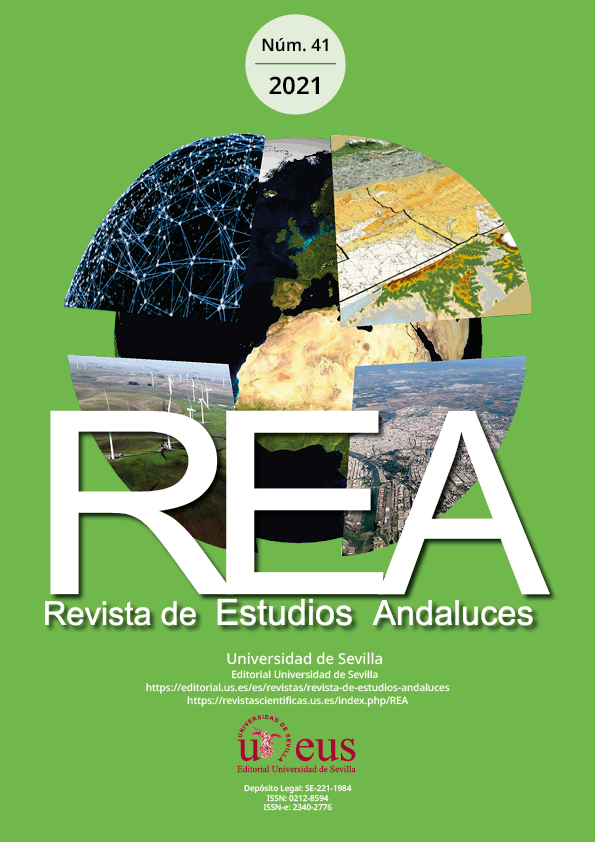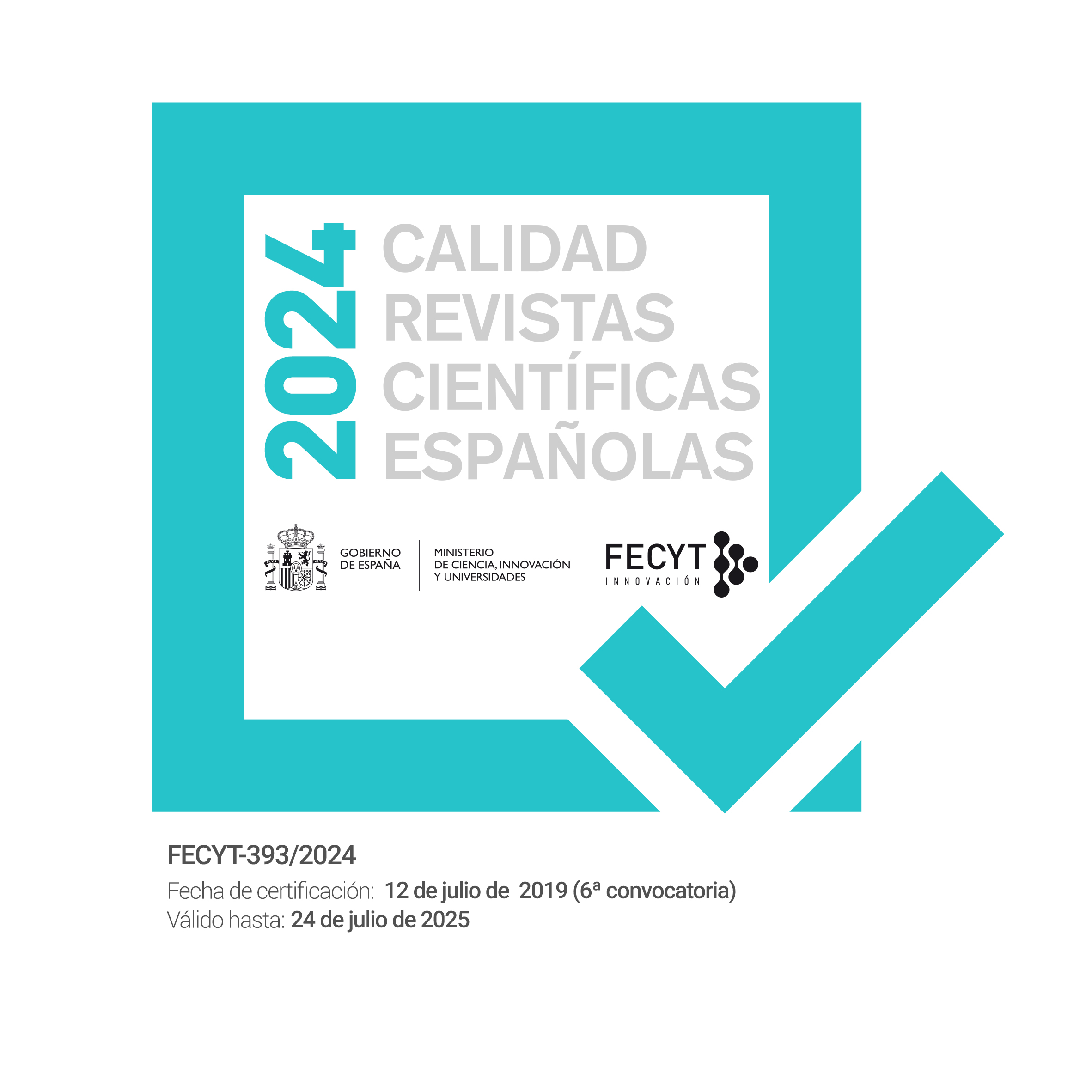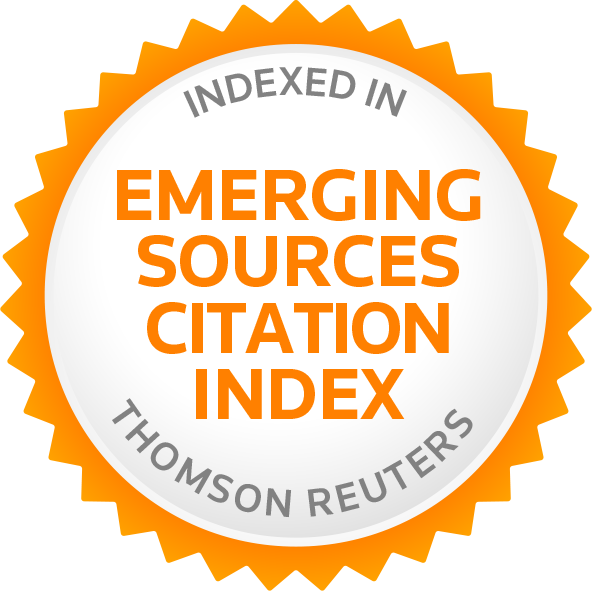Assessment of Social Vulnerability in Malaga Province, Spain: A Comparison of Indicator Standardization Techniques
DOI:
https://doi.org/10.12795/rea.2021.i41.05Palabras clave:
Vulnerabilidad social; Indicadores; Estandarización; Desastres naturalesResumen
La peligrosidad viene motivada por una serie de fenómenos extremos que pueden ser debidos a causas naturales, a actividades humanas o a una combinación de ambos aspectos. La vulnerabilidad social expresa las condiciones de las personas que pueden ser afectadas por determinados peligros. De cara a la prevención de los daños y pérdidas vinculadas a estos peligros, se hace necesario identificar a la población vulnerable en un territorio determinado a través de la generación de cartografía sobre vulnerabilidad social. En este trabajo, la zona estudiada se corresponde con la provincia de Málaga, que se localiza en la zona sur de España dentro de la Comunidad Autónoma de Andalucía. Un conjunto de 23 indicadores han sido aplicados para analizar la vulnerabilidad de la población de Málaga a nivel municipal. Para ello se han empleado tres técnicas de estandarización (transformación del valor máximo, transformación de las puntuaciones Z y transformación de valores mínimo y máximo) que han permitido la clasificación de los municipios en 5 categorías de vulnerabilidad. Los resultados muestran que existe una importante similitud entre las diferentes técnicas de estandarización elegidas. En todos ellas se detecta que los municipios más vulnerables desde un punto de vista socio-económico se sitúan en la zona occidental de la provincia de Málaga.
Descargas
Citas
Ahmad, H. F., Bhat, M. S., Alam, A. & Ahmad, S. (2016). Flood hazard zonation and vulnerability assessment of Greater Srinagar, J&K, India. Int. J. Adv. Res., 4(12), 1679-1690. http://dx.doi.org/10.21474/IJAR01/2570
Aksha, S. K., Juran, L., Resler, L. M. & Zhang, Y. (2019). An analysis of social vulnerability to natural hazards in Nepal using a modified social vulnerability index. Int J Disaster Risk Sci., 10, 103–116. https://doi.org/10.1007/s13753-018-0192-7
André, G. (2012). Natural hazard mapping across the world. A comparative study between a social approach and an economic approach to vulnerability. Cybergeo: European Journal of Geography. https://doi.org/10.4000/cybergeo.25297
Armenakis, C., Du, E. X., Natesan, S., Persad, R. A. & Zhang Y. (2017). Flood risk assessment in urban areas based on spatial analytics and social factors. Geosciences, 7(4), 123. https://doi.org/10.3390/geosciences7040123
Ayuso, J. L., Ayuso-Ruiz, P, García-Marín, A. P., Estévez, J. & Taguas, E. V. (2015). Local analysis of the characteristics and frequency of extreme droughts in Málaga using the SPI (Standardized Precipitation Index). 17th International Congress on Project Management and Engineering Logroño, 17-19th July 2013 (pp. 881-894). http://dx.doi.org/10.1007/978-3-319-12754-5_13
Balica, S.F., Douben, N. & Wright, N.G. (2009). Flood vulnerability indices at varying spatial scales. Water Science & Technology, 60(10). https://doi.org/10.2166/wst.2009.183
Barrionuevo, J. F. S. & Perles Roselló, M. J. (2017). Methodology for vulnerability mapping of the territory against the risk of flood related to assistance systems. Application to bajo Guadalhorse flood area. Geography Papers, 63. http://dx.doi.org/10.6018/geografia/2017/307051
Beccari, B. (2016). A comparative analysis of disaster risk, vulnerability and resilience composite indicators. PLOS Currents Disasters, 14(1). https://doi.org/10.1371/currents.dis.453df025e34b682e9737f95070f9b970
Birkmann, J., Cardona, O.D., Carreño, M.L., Barbat, A.H., Pelling, M., Schneiderbauer, S., Kienberger, S., Keiler, M., Alexander, D., Zeil, P. & Welle, T. (2013). Framing vulnerability, risk and societal responses: the MOVE framework. Nat Hazards, 67, 193–211. https://doi.org/10.1007/s11069-013-0558-5
Blaikie, P., Cannon, T., Davis, I. & Wisner, B. (1994). At risk: natural hazards, people vulnerability and disasters. 1st edition. Routledge.
Bukvic, A., Rohat, G., Apotsos, A. & de Sherbinin, A. (2020). A systematic review of coastal vulnerability mapping. Sustainability, 12, 2822. https://doi.org/10.3390/su12072822
Burton, C. G. (2010). Social vulnerability and hurricane impact modeling. Nat. Hazards Rev.,1182, 58–68. https://doi.org/10.1061/(ASCE)1527-6988(2010)11:2(58)
Burton, I., Kates, R. W. & White, G. F. (1978). The environment as hazard. Oxford University Press.
CAF (2014). Vulnerability index to climate change in the Latin American and Caribbean Region. Corporación Andina de Fomento. Development Bank of Latin America. 206 p.
Caliskan, S., Taubenböck, H., Hinz, S. & Roth A. (2006). Earthquake vulnerability indicators and vulnerability assessment using remote sensing, Istanbul. 1st EARSeL Workshop of the SIG Urban Remote Sensing. Humboldt-Universität zu Berlin, Germany. https://www.researchgate.net/publication/224798942
Cannon, T., Twigg, J. & Rowell, J. (2003). Social vulnerability, sustainable livelihoods and disasters. Report to DFID Conflict and Humanitarian Assistance Department (CHAD) and Sustainable Livelihoods Support Office. https://www.eldis.org/document/A21628
Cardona, 0. D. (2003). The need for rethinking the concepts of vulnerability and risk from a holistic perspective: A necessary review and criticism for effective risk management. In Bankoff, G. Frerks, D. Hilhorst (ed.) Mapping Vulnerability: Disasters, Development and People, Chapter 3. Earthscan Publishers.
Chakraborty, J., Tobin, G. A. & Montz, B. E. (2005). Population evacuation: assessing spatial variability in geophysical risk and social vulnerability to natural hazards. Natural Hazards Review, 6(1), 23–33. https://doi.org/10.1061/(ASCE)1527-6988(2005)6:1(23)
Chen, W., Cutter, S. L., Emrich, C. T. & Shi, P. (2013). Measuring social vulnerability to natural hazards in the Yangtze River delta region, China. Int. J. Disaster Risk Sci., 4(4), 169–181. https://link.springer.com/content/pdf/10.1007/s13753-013-0018-6.pdf
Contreras, D., Chamorro, A. & Wilkinson, S. (2020). Review article: The spatial dimension in the assessment of urban socio-economic vulnerability related to geohazards. Nat. Hazards Earth Syst. Sci., 20, 1663–1687. https://doi.org/10.5194/nhess-20-1663-2020
Copeland, V. C. & Snyder, K. (2011). Barriers to mental health treatment services for low-income African American women whose children receive behavioral health services: An ethnographic investigation. Social Work in Public Health, 26(1), 78-95. https://doi.org/10.1080/10911350903341036
Cutter, S. L., Boruff, B. J. & Shirley, W. L. (2003). Social vulnerability to environmental hazards. Social Science Quarterly, 84(2), 242-261. https://doi.org/10.1111/1540-6237.8402002
Cutter, S. L., Burton, C. G. & Emrich, C. T. (2010). Disaster resilience indicators for benchmarking baseline conditions. Journal of Homeland Security and Emergency Management, 7(1), 51. https://doi.org/10.2202/1547-7355.1732
de Mello Rezende, G. B. (2016). Social vulnerability index: A methodological proposal for application in the cities of Barra do Garcas—MT, Pontal Do Araguaia—MT and Aragarcas—GO, Brazil. Open Journal of Social Sciences, 4, 32-45. https://file.scirp.org/Html/4-1761151_72561.htm
de Oliveira Mendes, J. M. (2009). Social vulnerability indexes as planning tools: beyond the preparedness paradigm. Journal of Risk Research, 12(1), 43–58. https://doi.org/10.1080/13669870802447962
Diaz-Sarachaga, J. M. & Jato-Espino, D. (2020). Analysis of vulnerability assessment frameworks and methodologies in urban areas. Natural Hazards, 100, 437-457. https://doi.org/10.1007/s11069-019-03805-y
Djalante, R. (2019). Key assessments from the IPCC special report on global warming of 1.5 °C and the implications for the Sendai framework for disaster risk reduction. Progress in Disaster Science, 1. https://doi.org/10.1016/j.pdisas.2019.100001
Duzgun, H. S. B., Yucemen, M. S., Kalaycioglu, H. S., Celik, K., Kemec, S., Ertugay, K. & Deniz, A. (2011). An integrated earthquake vulnerability assessment framework for an urban area. Nat Hazards, 59, 917. https://doi.org/10.1007/s11069-011-9808-6
Dwyer, A., Zoppou, C., Nielsen, O., Day, S. & Roberts, S. (2004). Quantifying social vulnerability: A methodology for identifying those at risk to natural hazards. Geoscience Australia Record, 14. http://www.geosci.usyd.edu.au/users/prey/Teaching/Geos-2111GIS/Ref/GA4267-IdentifyingRisks.pdf
EEA (2018). Unequal exposure and unequal impacts: social vulnerability to air pollution, noise and extreme temperatures in Europe. European Environment Agency. EEA Report No 22. https://doi.org/10.2800/324183
Emrich, C. T. & Cutter, S. L. (2011). Social vulnerability to climate-sensitive hazards in the Southern United States. Weather, Climate, and Society, 3 (3), 193–208. https://doi.org/10.1175/2011WCAS1092.1
Evans, J. M., Hauer, M., Hardy, D. & Pippin, J. S. (2014). Assessing social vulnerability using ‘‘SoVI-Lite’’: A demonstration study at Glynn County, GA. Carl Vinson Institute of Government, University of Georgia. https://doi.org/10.13140/2.1.2329.3765
Flanagan, B. E., Gregory, E. W., Hallisey, E. J., Heitgerd, J. L. & Lewis, B. (2011). A social vulnerability index for disaster management. Journal of Homeland Security and Emergency Management, 8(1), 3. https://svi.cdc.gov/A%20Social%20Vulnerability%20Index%20for%20Disaster%20Management.pdf
Fekete, A. (2009). Validation of a social vulnerability index in context to river-floods in Germany. Nat. Hazards Earth Syst. Sci., 9, 393–403. https://doi.org/10.5194/nhess-9-393-2009
Fekete, A. (2018). Social vulnerability change assessment: monitoring longitudinal demographic indicators of disaster risk in Germany from 2005 to 2015. Natural Hazards, 95, 585–614. https://doi.org/10.1007/s11069-018-3506-6
Frigerio, I., Carnelli, F., Cabinio, M. & Amicis, M. D. (2018). Spatiotemporal pattern of social vulnerability in Italy. Int J Disaster Risk Sci., 9(2), 249–262. https://doi.org/10.1007/s13753-018-0168-7
Gallegos Reina, A., (2013). Cuantificación y distribución cartográfica de la generación de escorrentía y sedimentos en la provincia de Málaga. Baetica. Estudios de Arte, Geografía e Historia, 35, 57-74. http://hdl.handle.net/10630/7823
Gallegos Reina, A. & Perles Roselló, M. J. (2019). Relaciones entre los cambios en los usos del suelo y el incremento de los riesgos de inundabilidad y erosión: análisis diacrónico en la provincia de Málaga (1957–2007). Boletín de La Asociación de Geógrafos Españoles, 81, 2740, 1–38. http://dx.doi.org/10.21138/bage.2740
Gayen, S., Villalta, I. V. & Haque, S. K. (2019). Earthquake hazard scenario and seismic micro-zoning assessment in Málaga province of Spain. European Journal of Geography, 10(1), 117-133. http://www.eurogeographyjournal.eu/articles/0810012019.pdf
Gayen, S., Villalta, I. V. & Haque, S. M. (2020). Comparative Social Vulnerability Assessment in Purba Medinipur District, West Bengal, India. European Journal of Geography, 11(1), 093-107. https://doi.org/10.48088/ejg.s.gay.11.1.93.107
Ge, Y., Dou, W. and Dai, J. (2017). A new approach to identify social vulnerability to climate change in the Yangtze River delta. Sustainability, 9(12), 2236. https://doi.org/10.3390/su9122236
Girasole, E. G., and Cannatella, D. (2017). Social vulnerability to natural hazards in urban systems. An application in Santo Domingo (Dominican Republic). Sustainability, 9(11), 2043. https://doi.org/10.3390/su9112043
Gu, D. (2019). Exposure and vulnerability to natural disasters for world’s cities. United Nations, Department of Economics and Social Affairs, Population Division, Technical Paper No. 4. https://www.un.org/en/development/desa/population/publications/pdf/technical/TP2019-4.pdf
Guillard-Gonçalves, C., Cutter, S. L., Emrich, C. T. & Zêzere, J. L. (2015). Application of social vulnerability index (SoVI) and delineation of natural risk zones in Greater Lisbon, Portugal. Journal of Risk Research, 18(5), 651-674. https://doi.org/10.1080/13669877.2014.910689
Gutiérrez-Hernández, O., Senciales-González, J. M. & García, L. V. (2015). Los incendios forestales en Andalucía: investigación exploratoria y modelos explicativos. FLAMMA, 6(3), 144-148. https://www.academia.edu/26652060/Los_incendios_forestales_en_Andaluc%C3%ADa_investigaci%C3%B3n_exploratoria_y_modelos_explicativos_Wildfires_in_Andalusia_Spain_from_exploratory_research_to_explanatory_models
Hoffmann, R. & Blecha, D. (2020). Education and disaster vulnerability in Southeast Asia: Evidence and policy implications. Sustainability, 12, 1401. https://doi.org/10.3390/su12041401
Holand, I. S., Lujala, P. & Rød, J. K. (2011). Social vulnerability assessment for Norway: A quantitative approach. Norsk Geografisk Tidsskrift - Norwegian Journal of Geography, 65(1), 1-17. https://doi.org/10.1080/00291951.2010.550167
Insua-Arévalo, J. M., Martínez-Díaz, J. J., García-Mayordomo, J. & Martín-González, F. (2012). Active tectonics in the Malaga Basin: evidences from morphotectonic markers (Western Betic Cordillera, Spain). Journal of Iberian Geology, 38 (1), 175–190. http://dx.doi.org/10.5209/rev_JIGE.2012.v38.n1.39212
Kablan, M.K.A., Dongo, K. & Coulibaly, M. (2017). Assessment of social vulnerability to flood in Urban Côte d’Ivoire Using the MOVE Framework. Water, 9(4), 292. https://doi.org/10.3390/w9040292
Kalaycıoğlu, S., Rittersberger-Tılıç, H., Çelik, K. & Güneş, F. (2006). Integrated natural disaster risk assessment: The socio-economic dimension of earthquake risk in the urban area. Geohazards- Engineering Conferences International. https://dc.engconfintl.org/cgi/viewcontent.cgi?article=1013&context=geohazards
Khan, F. A. & Salman, A. (2012). A simple human vulnerability index to climate change hazards for Pakistan. Int. J. Disaster Risk Sci., 3(3), 163–176. https://link.springer.com/content/pdf/10.1007/s13753-012-0017-z.pdf
Kirby, R. H. (2015). Measuring social vulnerability to environmental hazards in the Dutch Province of Zeeland. LSU Master’s Theses. 3800. https://digitalcommons.lsu.edu/gradschool_theses/3800
Koks, E. E., Jongman, B., Husby, T. G. & Botzen, W. J. W. (2015). Combining hazard, exposure and social vulnerability to provide lessons for flood risk management. Environmental Science & Policy, 47, 42–52. https://doi.org/10.1016/j.envsci.2014.10.013
Kuhlicke, C., Scolobig, A., Tapsell, S., Steinfu¨hrer, A. & Marchi, B. D. (2011). Contextualizing social vulnerability: findings from case studies across Europe. Nat Hazards, 58, 789–810. https://link.springer.com/article/10.1007/s11069-011-9751-6
Lee, Y. J. (2014). Social vulnerability indicators as a sustainable planning tool. Environmental Impact Assessment Review, 44, 31–42. https://doi.org/10.1016/j.eiar.2013.08.002
Lowe, D., Ebi, K. L. & Forsberg, B. (2013). Factors increasing vulnerability to health effects before, during and after floods. Int. J. Environ. Res. public Health, 10(12), 7015–7067. https://doi.org/10.3390/ijerph10127015
Mavhura, E., Manyena, B. & Collins, A. E. (2017). An approach for measuring social vulnerability in context: The case of flood hazards in Muzarabani district, Zimbabwe. Geoforum, 86, 103–117. https://doi.org/10.1016/j.geoforum.2017.09.008
Madeca (2017). Estudio sobre la problemática por el riesgo de inundaciones en la provincia de Málaga. Madeca. Page, 112.
Morales, A. P., Hervás, F. N. & Rogel, Y. A. (2016). Propuesta metodológica para la evaluación de la vulnerabilidad social en poblaciones afectadas por el peligro de inundación: el caso de Águilas (Murcia, sureste). Documents d’Anàlisi Geogràfica, 62(1). https://doi.org/10.5565/rev/dag.242
Morrow, B. H. (1999). Identifying and mapping community vulnerability. Disasters, 23(1), 1-18. https://doi.org/10.1111/1467-7717.00102
Muhadi, N. A., Abdullah, A. F., Bejo, S. K., Mahadi, M. R. & Mijic, A. (2020). The use of LiDAR-Derived DEM in flood applications: A review. Remote Sens., 12 (14), 2308. https://doi.org/10.3390/rs12142308
Müller, A., Reiter, J. & Weiland, U. (2011). Assessment of urban vulnerability towards floods using an indicator-based approach – a case study for Santiago de Chile. Nat. Hazards Earth Syst. Sci., 11(8), 2107-2123. https://doi.org/10.5194/nhess-11-2107-2011
Navarro, D., Vallejo, I. & Navarro, M. (2020). Análisis de la vulnerabilidad social a los riesgos naturales mediante técnicas estadísticas multivariantes. Investigaciones Geográficas, 74, 29-49. https://doi.org/10.14198/INGEO2020.NVN
Papathoma-Köhle, M., Schlögl, M. & Fuchs, S. (2019). Vulnerability indicators for natural hazards: an innovative selection and weighting approach. Sci Rep, 9, 15026. https://doi.org/10.1038/s41598-019-50257-2
Pencheon, D. (2007). The good indicators guide: Understanding how to use and choose indicators. NHS Institute for Innovation and Improvement, Coventry, UK. https://www.england.nhs.uk/improvement-hub/wp-content/uploads/sites/44/2017/11/The-Good-Indicators-Guide.pdf
Perles-Roselló, M. J. (2010). Apuntes para la evaluación de la vulnerabilidad social frente al riesgo de inundación. Baetica. Estudios de Arte, Geografía e Historia, 32, 67-87. https://doi.org/10.24310/BAETICA.2010.v0i32.133
Perles Roselló, M.J., Sortino Barrionuevo, J.F. & Cantarero Prados, F. (2017). Cartografía de la vulnerabilidad del territorio frente al riesgo de inundación. Propuesta adaptada a la directiva europea de inundaciones ynormativas derivadas. Boletín de la Asociación de Geógrafos Españoles, 75. 341-372. https://doi.org/10.21138/bage.2504
Pharr, J. R., Moonie, S. & Bungum, T. J. (2012). The impact of unemployment on mental and physical health, access to health care and health risk behaviors. ISRN Public Health, 483432. https://doi.org/10.5402/2012/483432
Prieto, A., Díaz, M. P., Ojeda J. & Álvarez, J. I. (2017). Tasas de erosión en las playas de Andalucía: el efecto de infraestructuras costeras longitudinales y urbanización. Geotemas, 243-246. https://www.researchgate.net/publication/324720318_Tasas_de_erosion_en_las_playas_de_Andalucia_el_efecto_de_infraestructuras_costeras_longitudinales_y_urbanizacion
Ran, J., MacGillivray, B. H., Gong, Y. & Hales, T. C. (2020). The application of frameworks for measuring social vulnerability and resilience to geophysical hazards within developing countries: A systematic review and narrative synthesis. Science of the Total Environment, 711, 134486. https://doi.org/10.1016/j.scitotenv.2019.134486
Reid, C. E., O’Neill, M. S., Gronlund, C. J., Brines, S. J., Brown, D. G., Diez-Roux, A. V. & Schwartz, J. (2009). Mapping community determinants of heat vulnerability. Environmental Health Perspectives, 117(11), 1730-1736. https://doi.org/10.1289/ehp.0900683
Rodríguez, H., Quarantelli, E. L. & Dynes, R. R. (2007). Handbook of Disaster Research. Springer.
Sajjad, H. & Jain, P. (2014). Assessment of socio-economic vulnerabilities among urban migrants in South-East Delhi, India. Journal of Studies in Social Sciences, 7(1), 65-81. https://infinitypress.info/index.php/jsss/article/view/652
Sánchez, D. S. & Del Moral, L. (2014). Tres décadas de política de aguas en Andalucía. Análisis de procesos y perspectiva territorial. Cuadernos Geográficos, 53(1), 36-67. http://hdl.handle.net/11441/43624
Sen, A. (1998). Mortality as an indicator of economic success and failure. The Economic Journal, 108 (446), 1-25. https://doi.org/10.1111/1468-0297.00270
Tali, M.G., Naeimi, A. & Esfandiary, M. (2016). Physical development of Arak City applying natural indicators. European Journal of Geography, 7(3), 99 – 110. http://www.eurogeographyjournal.eu/articles/7.PHYSICAL%20DEVELOPMENT%20OF%20ARAK%20CITY%20APPLYING%20NATURAL%20INDICATORS.pdf
Tapsell, S., Tunstall, S., Green, C. & Fernández-Bilbao, A. (2005). Task 11 social indicator set. FLOODsite Project Report, T11–5-01. http://www.floodsite.net/html/partner_area/project_docs/M11.1_Indicator-set_7-05.pdf
Tascón-González, L., Ferrer-Julià, M., Ruiz, M. & García-Meléndez, E. (2020). Social vulnerability assessment for flood risk analysis. Water, 12(2), 558. https://doi.org/10.3390/w12020558
Thomas, V. & López, R., (2015). Global increase in climate-related disasters. Asian Development Bank Economics Working Paper Series No. 466. http://dx.doi.org/10.2139/ssrn.2709331
Török, I. (2018). Qualitative assessment of social vulnerability to flood hazards in Romania. Sustainability, 10, 3780. https://doi.org/10.3390/su10103780
UN (2016). Report of the open-ended intergovernmental expert working group on indicators and terminology relating to disaster risk reduction. Prevention web, UNDRR, Geneva, Switzerland.
Wamsler, C., Brink, E. & Rantala, O. (2012). Climate change, adaptation, and formal education: The role of schooling for increasing societies’ adaptive capacities in El Salvador and Brazil. Ecology & Society, 17(2), 2. https://doi.org/10.5751/ES-04645-170202
Weichselgartner, J. (2001). Disaster mitigation: The concept of vulnerability revisited. Disaster Prevention and Management, 10(2), 85-95. https://doi.org/10.1108/09653560110388609
Wisner, B., Blaikie, P., Cannon, T. & Davis, I. (2004). At risk: natural hazards, people’s vulnerability and disasters. Second edition, Routledge.
Wu, S. Y., Yarnal, B. & Fisher, A. (2002). Vulnerability of coastal communities to sea-level rise: A case study of Cape May County, New Jersey, USA. Climate Research, 22, 255–270. https://www.int-res.com/abstracts/cr/v22/n3/p255-270/
Yan, X. & Li, X. (2016). Evaluation on social vulnerability to natural disasters. The Anthropologist, 24(2), 570–580.
https://doi.org/10.1080/09720073.2016.11892051
Yang, S., He, S., Du, J. & Sun, X. (2014). Screening of social vulnerability to natural hazards in China. Nat Hazards, 76, 1–18. https://doi.org/10.1007/s11069-014-1225-1
Yoon, D. K. (2012). Assessment of social vulnerability to natural disasters: a comparative study. Nat. Hazards, 63, 823–843. https://doi.org/10.1007/s11069-012-0189-2
Zhang, N. & Huang, H. (2013). Social vulnerability for public safety: A case study of Beijing, China. Chinese Science Bulletin, 58 (19), 2387-2394. https://doi.org/10.1007/s11434-013-5835-x
Žurovec, O., Cˇadro, S. & Sitaula, B. K. (2017). Quantitative assessment of vulnerability to climate change in rural municipalities of Bosnia and Herzegovina. Sustainability, 9(7), 1208. https://doi.org/10.3390/su9071208
Descargas
Publicado
Cómo citar
Número
Sección
Licencia
Derechos de autor 2021 Revista de Estudios Andaluces

Esta obra está bajo una licencia internacional Creative Commons Atribución-NoComercial-SinDerivadas 4.0.
La edición electrónica de la Revista de Estudios Andaluces se ofrece en acceso abierto desde el número 28 publicado en 2011 hasta la actualidad. Las ediciones impresa y electrónica de esta Revista son editadas por la Editorial de la Universidad de Sevilla, siendo necesario citar la procedencia en cualquier reproducción parcial o total.
La Revista de Estudios Andaluces no cobra tasas por el envío de trabajos, ni tampoco cuotas por la publicación de sus artículos. La Revista es gratuita desde el momento de la publicación de cada número y sus contenidos se distribuyen con la licencia “CreativeCommons Atribución-NoComercial-SinDerivar 4.0 Internacional” , que permite al usuario de la Revista de Estudios Andaluces criterios que cumplen con la definición de open access de la Declaración de Budapest en favor del acceso abierto. Puede consultar desde aquí la versión informativa y el texto legal de la licencia. Esta circunstancia ha de hacerse constar expresamente de esta forma cuando sea necesario.







